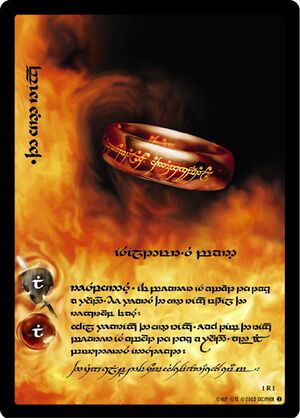Tengwar
For a description of the physical product that contained most Tengwar cards, see Tengwar Anthologies.

Tengwar is the name for the writing system used by Elves throughout the history of Middle-earth. Details on the writing itself can be found here, here, here, and here.
Within the LotR-TCG, special promotional cards were released with all text written using this script. The text was hand-lettered by noted New Zealand artist Daniel Reeve, the official calligrapher and cartographer of The Lord of the Rings movies. His work includes the text shown on the inscription of The One Ring and the text within the pages of the Book of Mazarbul.
Most Tengwar cards were released in 18-card batches called Tengwar Anthologies, which were released one per 3-set Block (Hunters never got one due to Decipher's decline). A handful were released as special event rewards or promotions in between anthology releases.
Tengwar cards were legal to use in sanctioned Decipher tournaments and were considered identical to their English counterparts for gameplay purposes.
German Tengwar[edit]
German Tengwar cards for the first three Anthology sets were exactly the same as all other languages--namely, the same as the English version (there wasn't much point after all in re-transcribing a language that, realistically, practically no-one could read). However, the German version of The War of the Ring Anthology is in fact transcribed in German, unique to all non-English language Tengwar cards.
The German Tengwar cards are noticeably more amateur than the hand-written ones made by Daniel Reeve. The mode used doesn't appear to follow any known Tengwar mode, meaning that the authors likely just assigned letters to tengwa at random. There is also a curious combination of vowels-as-glyphs and vowels-as-diacritic, possibly indicating that diacritics were used as direct translations of German diacritics. On top of this, the lore font appears to have some missing letters, meaning that at times it will default to the game text font's letters, causing a jarring formatting switch partway through words.
Seeing as these cards were only "discovered" to exist in 2020, it's unknown whether any other overseas printers produced their own versions as well.
Tengwar Transcription Details[edit]
Tengwar as a writing system is not inherently tied to any one spoken language, and as a result has many "modes" which define what each letter is to be interpreted as. Daniel Reeve, the Weta calligraphist, used his own mode which is close but not identical to the standard English mode, with vowels as full characters instead of diacritics. As a starting point, compare it to the "Westron Orthographic" mode as described on tecendil.com.
The character differences are as follows:
- Uses essë (normally a Z glyph) instead of quessë-with-a-hook for X
- Uses essë nuquerna for Z, and never essë (both are valid)
- Uses órë consistently for all instances of R, instead of reserving it for final Rs (and thus never uses rómen for non-final R)
- Uses rómen for W (instead of úrë)
- Uses ungwë with an upper bar for NG instead of the dedicated ñwalmë character
- Uses calma (normally CH) for C in all cases instead of quessë or silme nuquerna
- Uses hwesta for CH (it normally is only CH in situations like "echo" that are actually a K sound)
- Uses anga for GH (normally J) instead of unquë
Most of these differences are a matter of eliminating redundancies, both of the same pronunciation in multiple letters, and different pronunciations with the same letter representations, reducing the total amount of work to convert English into printable Tengwar.
In addition, the following rules can be observed in the printed mode:
- Ending nasal ND, NG, NT, MB etc combinations are always indicated with the N or M dropped and a line placed over the final letter (this is standard).
- Final silent E is always dropped and indicated by a dot under the penultimate letter (this is standard).
- Double letters are always indicated by dropping the second and placing a line under the first (this is standard).
- Standard "the" and "of" abbreviations are always used.
- Dipthong combinations (where the second letter is dropped and its corresponding diacritic are attached to the previous vowel) are consistently used.
- English diacritics (Nazgûl, Théoden) are never represented.
- Proper little-endian base 10 numbers are always used (meaning that "17" is written as "71"), and the dot is always placed above the number to indicate it is base 10.
- +1 is always fully written out as "plus 1" (using proper numbers)
- In game text, various alternate spellings may be used for space or aesthetic concerns, such as writing "phase" as "fase" or "shadow" as "shadou", even though the mode used is not phonetic.
- In lore, the rules become much more flexible and Reeve clearly opts for aesthetics and space over accuracy.
- Vowel diacritics are used instead of full letters, but the vowels go on the previous character instead of the following character, the same way that the Quenya mode works.
- Double EE (as dots) will often be used as final Y long e sounds (lonely -> lonelee, enemy -> enemee)
| LOTR-TCG Product |
|---|